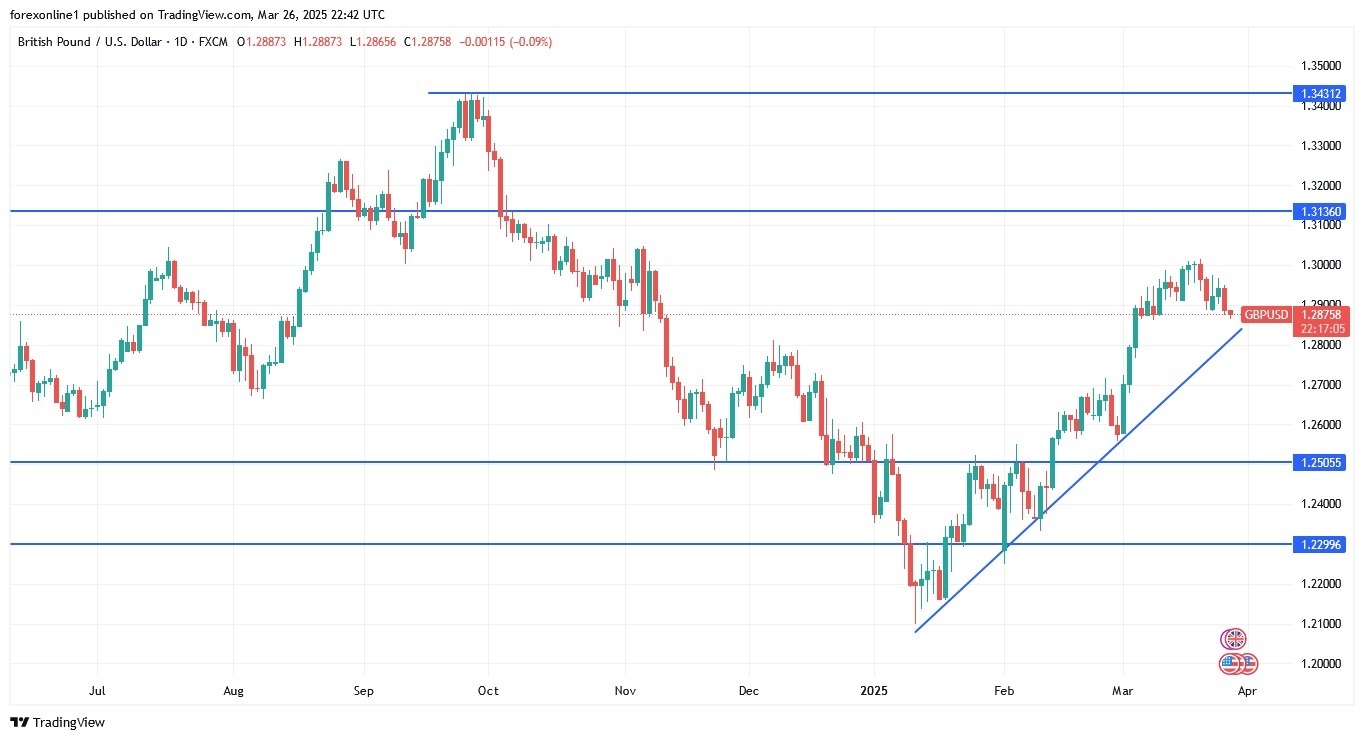Key points for GBPUSD analysis:
- The British pound is affected by UK inflation and budget announcements.
- The Bank of England may be prepared to cut interest rates.
- The US dollar is stronger ahead of economic growth readings.
Selling pressure on the British pound against other major currencies has increased after the Office for National Statistics announced a monthly rise in the UK Consumer Price Index (CPI) of 0.4% month-on-month, below the expected 0.5%. According to the economic calendar data, the annual CPI inflation in Britain fell to 2.8% from 3.0% in January 2025, while expectations were for a 2.9% increase. This decline is mainly attributed to a fall in clothing and footwear prices on an annual basis (-0.6%), marking the first negative rate since October 2021.
Top Forex Brokers
According to forex market trading, the GBP/USD pair fell to the 1.2873 support level, where it remained at the time of writing.
UK Inflation and Its Impact on Bank of England Policies
As officially announced, CPI inflation in the services sector, which the Bank of England closely monitors, remained stable at 5.0%. The core CPI inflation rate, another important measure for the bank, fell to 3.5% in February 2025, down from 3.7% in January, and below the expected 3.6%. While inflation remains significantly above the Bank of England's 2.0% target, its fall below expectations has led to a decline in the currency's value.
Overall, following the data release, traders raised their expectations for another Bank of England interest rate cut in May to 80%. The increased likelihood of a May rate cut reflects a slight decline in UK bond yields and a decline in the value of the pound. However, the Bank of England will remain limited in its ability to cut interest rates frequently, as inflation remains stubbornly high, and economists warn it will rise further.
On the monetary policy front, Andrew Sentance, a former member of the Bank of England's Monetary Policy Committee, says that rising national insurance contributions and energy and water prices are likely to push CPI inflation to over 4%. He adds, "It is expected to reach 5% or more in the fall." Therefore, inflationary pressures are high, which will limit the decline in UK bond yields and the British pound's exchange rates. However, not all economists agree that inflationary pressures will continue to rise. Deutsche Bank, for example, believes that the rationale for consecutive interest rate cuts is increasing.
According to currency trading experts, a faster decline in bank interest rates is likely in the coming months, which will negatively impact the British pound next year. In fact, the accelerated decline in interest rates in the UK is a major reason why many leading foreign exchange experts expect the pound to decline in the coming quarters.
Trading Tips:
As predicted, the failure of sterling bulls to maintain the psychological peak of 1.30 will increase selling pressure. The downward shift is ongoing.
UK stock prices rebound after economic data.
According to recent trading on stock trading company platforms, the UK FTSE 100 index maintained its gains, closing at 8690 points, mainly driven by the weak British pound after the unexpected decline in UK inflation to 2.8%, which boosted the income of London residents from abroad. However, UK Finance Minister Rachel Reeves’ Spring statement added little new optimism for investors. Many key announcements, such as changes to social care and the National Health Service, were well-known, and their impact on the market was limited.
But the biggest disappointment came from the Office for Budget Responsibility's revised growth forecast for the UK, which was cut from 2% to just 1% for 2024. This weighed on sentiment, particularly in the housing sector, where shares of major housebuilders fell before recovering. The UK government also admitted it would miss its target of building 1.5 million homes, revising its forecast to 1.3 million. Investors had hoped for bolder action on planning reforms to stimulate growth.
Meanwhile, defence shares, such as BAE Systems, rebounded after Reeves pledged to increase spending, while Shell continued its gains following its strategy update.
Technical Analysis for the GBP/USD pair today:
According to the daily chart performance, and as previously predicted, the GBP/USD bulls' abandonment of the 1.3000 psychological resistance level will incentivize bears to move with sell orders to take profits downward. This is what happened, and currently, selling pressure on the GBP/USD will increase if the pair moves towards the 1.2800 support level. The technical indicators, led by the Relative Strength Index (RSI) and the Moving Average Convergence Divergence (MACD), have turned downward. Conversely, on the same timeframe, the 1.3000 psychological resistance level remains crucial for the bulls to control the GBP/USD trend.
Today's economic calendar will be devoid of any significant UK economic releases. The focus will be on US releases, led by the GDP growth reading and the weekly US jobless claims. Additionally, the GBP/USD will react to investors' risk appetite.
Ready to trade our daily Forex GBP/USD analysis? We’ve made this UK forex brokers list for you to check out.

